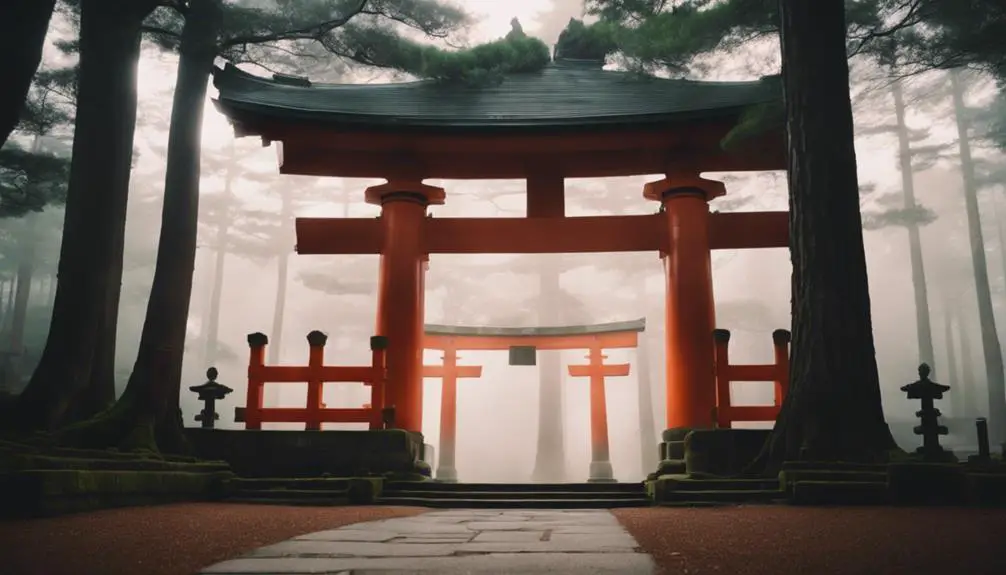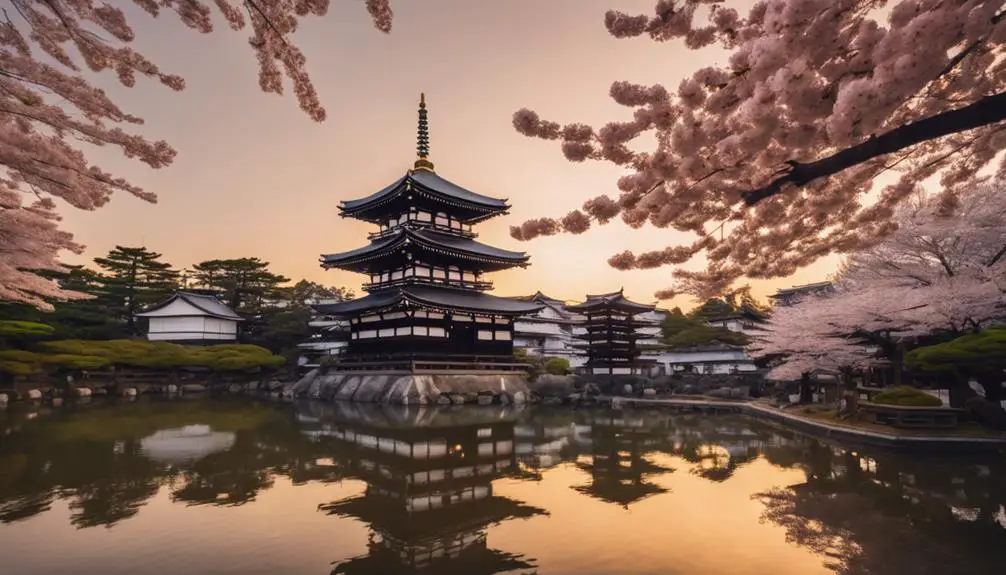7 Ancient Sites in Nara That Tell Japan’s Rich History
In Nara, you'll find Todai-ji Temple, a UNESCO site illustrating Japan's cultural and religious evolution through its architectural marvel, the Great Buddha. Nearby, Horyu-ji, among the oldest wooden buildings globally, exemplifies cultural exchanges between Japan and Korea. Explore Kofuku-ji Temple's five-story pagoda, a beacon of architectural ambition and historical lore. Yakushi-ji, with its East Pagoda, integrates significant Chinese influences, while Toshodai-ji highlights meticulous craftsmanship in its serene grounds. Gangoji Temple fosters an appreciation of Japan's artistic heritage, and Kasuga-Taisha Shrine, surrounded by whispering forests, reveals the spiritual protectors of Nara. Each site offers profound insights that await your further exploration.
Todai-ji Temple Overview
Todai-ji Temple, a UNESCO World Heritage Site nestled in the heart of Nara, Japan, stands as a monumental demonstration of the cultural and religious evolution during the Nara period. You'll discover that this architectural marvel not only houses the Great Buddha, a colossal statue representing strength and wish fulfillment, but also exemplifies ancient Japanese architecture in its grandest form.
At the core of Todai-ji, the Daibutsuden Hall, reputed as the largest wooden building in the world, presents a fascinating study in structural ingenuity and aesthetic detail. The scale and design of the hall underscore a significant era when religious and cultural influx inspired new architectural techniques and styles. This period marked a pivotal point in Japanese history, where Buddhism became a central influence, affecting everything from politics to art.
As you explore, you'll appreciate how Todai-ji Temple encapsulates the synthesis of spiritual and practical aspects of Japanese culture. The temple not only served as a religious sanctuary but also played an essential role in the cultural unification and state formation in Japan. Through its ongoing preservation efforts, Todai-ji continues to be a living witness to Japan's historical and cultural continuity.
The Mystique of Kasuga-Taisha

Kasuga-Taisha, established in 768 AD, captivates visitors with its thousands of lanterns, each symbolizing the hopes and prayers of worshippers throughout the ages. As a UNESCO World Heritage Site, this Shinto shrine embodies the spiritual and historical essence of Nara. The enchanting forest that surrounds Kasuga-Taisha enhances its mystical allure, inviting you to explore deeper into its sacred grounds.
The deity honored here is known as the protector of Nara, reflecting the shrine's integral role in the city's spiritual life. The lanterns, donated by devotees, are not merely decorative. They represent a luminous bridge between the divine and the earthly, a confirmation to centuries of unbroken faith and tradition.
Here's a detailed breakdown to enhance your understanding:
| Feature | Description | Significance |
|---|---|---|
| Hanging Lanterns | Thousands, donated by worshippers | Symbolize hopes and continuity |
| Forest Surrounding | Serene, part of the shrine complex | Adds to the shrine's mystique |
| Deity | Protector of Nara | Central to local spiritual life |
| UNESCO Status | Part of 'Historic Monuments of Ancient Nara' | Marks global recognition |
| Founding Year | 768 AD | Highlights historical importance |
This table encapsulates why Kasuga-Taisha is not just a site of worship but a profound cultural landmark, weaving the historical tapestry of Nara into the present.
Horyu-ji Area Insights

Exploring further into Nara's rich religious heritage, the Horyu-ji Area stands as a pivotal site where you can witness the early adaptation and flourishing of Buddhism in Japan through its ancient architectural wonders. Designated as a UNESCO World Heritage Site, this area encapsulates the dawn of Japanese Buddhist constructions, with Horyu-ji Temple and Hokiji Temple at its core.
Horyu-ji Temple, constructed in the 7th century, represents one of the oldest wooden structures in the world. Its architectural design not only exemplifies the ingrained artistry of early Japanese craftsmanship but also embodies the significant cultural exchange between Japan and the Korean Peninsula. This exchange is palpable in the temple's layout and decorative elements, which illustrate a blend of Japanese ingenuity and continental influences.
Adjacent to this, Hokiji Temple serves as another cornerstone of historical and architectural study. Though smaller, its presence in the Horyu-ji Area highlights the diversification and evolution of temple construction techniques over time. The intricate wooden carvings and spatial harmony seen here are essential for understanding the progression and localization of Buddhist architectural styles in Japan.
Together, these temples provide an insightful view into the genesis and refinement of Buddhist architecture in Japan, marking the Horyu-ji Area as a pivotal chapter in the narrative of Japan's rich history.
Exploring Kofuku-ji Temple

Kofuku-ji Temple, a landmark of ancient Nara, stands as proof of the city's storied past and religious significance. As you explore this Buddhist temple, you're not just walking through a mere physical space but also traversing through centuries of religious devotion and cultural accumulation. Established in 669 and relocated to Nara in 710, Kofuku-ji reflects the dynamic shifts in Japanese Buddhism and political power.
The temple's five-story pagoda, soaring elegantly into the skyline, isn't only Nara's iconic symbol but also a confirmation of architectural ingenuity from centuries past. This pagoda, together with the Eastern Golden Hall, houses an array of cultural treasures that offer you a tangible connection to Nara's rich heritage. These structures are meticulously preserved, embodying the spiritual and historical essence of the era.
As you explore further into the temple grounds, the various Buddhist statues you encounter aren't merely artistic expressions but are venerable objects of worship, steeped in the devout practices of the people through the ages. Each artifact and building corner at Kofuku-ji Temple narrates a piece of the grand tapestry of Japanese cultural and religious history, inviting you to reflect on the continuity and change that have shaped this sacred site.
Secrets of Yakushi-ji Temple

Delving into the architectural marvels of Yakushi-ji Temple, you uncover a pivotal site that embodies the zenith of Nara Period craftsmanship and Buddhist influence. Established in the 7th century, this UNESCO World Heritage Site serves not only as a demonstration of ancient religious devotion but also as a beacon of art and architecture from that era.
- East Pagoda's Significance: The East Pagoda, remarkably preserved, stands as one of the few structures from the Nara Period that survives in its original form. Its architectural style is a direct import from Chinese Buddhist influences, showcasing an integration of cultural and spiritual ideas that crossed borders.
- Yakushi Nyorai Statue: Central to the temple is the Yakushi Nyorai statue, a National Treasure. This icon represents healing and compassion, reflecting the core values of Buddhism at the time.
- Murals and Sculptures: The main hall is adorned with intricate murals and sculptures that are prime examples of early Japanese Buddhist art, offering insights into the religious narratives and aesthetic values of the period.
- Architectural Influence: Yakushi-ji's layout and design reflect significant Chinese influence, highlighting the cultural exchange that shaped early Japanese Buddhism and contributed to the development of unique styles of Buddhist art.
In exploring Yakushi-ji Temple, you're not just walking through a historical site but engaging with a cornerstone of Buddhist art and architecture from the Nara Period.
Toshodai-ji Temple Highlights

Founded by the Chinese monk Jianzhen in the 8th century, Toshodai-ji Temple stands as proof of the cultural and architectural exchange between Japan and China during that era. As you explore this UNESCO World Heritage Site, you'll notice the distinct influence of Chinese Tang Dynasty architecture, particularly in the temple's main hall, Kondo. This architectural style is characterized by its symmetrical layout and ornate wooden carvings, which signify the temple's historical importance and the meticulous artistry of its creators.
The Kondo, a central element in the temple's design, houses a significant artifact—the statue of the Yakushi Buddha, also known as the Medicine Buddha. This statue not only serves as a spiritual focal point but also exemplifies the cultural and religious synthesis that Toshodai-ji represents. The presence of the Yakushi Buddha highlights the temple's role in the dissemination of Buddhist teachings and medicinal knowledge across Asia.
Surrounding the temple, the serene gardens offer you a peaceful retreat, reflecting the contemplative nature of the site. These gardens, coupled with the temple's storied architecture, provide a tangible connection to Japan's rich historical tapestry. Toshodai-ji's blend of spiritual significance and cultural exchange makes it a key site in understanding Nara's historical landscape.
Gangoji Temple's Significance

Gangoji Temple, established in the 6th century as one of Nara's Seven Great Temples, serves as a pivotal landmark in the spread of Buddhism throughout Japan. As you explore further into its history, you'll find that Gangoji Temple isn't just a mere structure; it encapsulates the essence of early Japanese Buddhism and its syncretic evolution with continental influences.
Here are key aspects that highlight the significance of Gangoji Temple:
- Cultural Integration: The architectural style of Gangoji shows a sophisticated blend of Japanese and continental designs, which illustrates the cultural dialogue between Japan and the Asian mainland during its formative years.
- Artistic Heritage: The temple houses ancient artifacts and pagodas, offering a window into Nara's rich artistic tradition and providing invaluable insights into the aesthetic preferences of early Japanese society.
- Historical Influence: Gangoji's role in propagating Buddhist teachings helped shape the spiritual landscape of Japan, making it a cornerstone in the study of Japanese religious history.
- Preservation Efforts: Ongoing conservation projects at Gangoji underscore its importance as a beacon of cultural heritage and help maintain its legacy for future generations.
Understanding Gangoji Temple's role in these areas enhances your appreciation of how Buddhist temples have shaped and preserved the cultural heritage of Japan.
